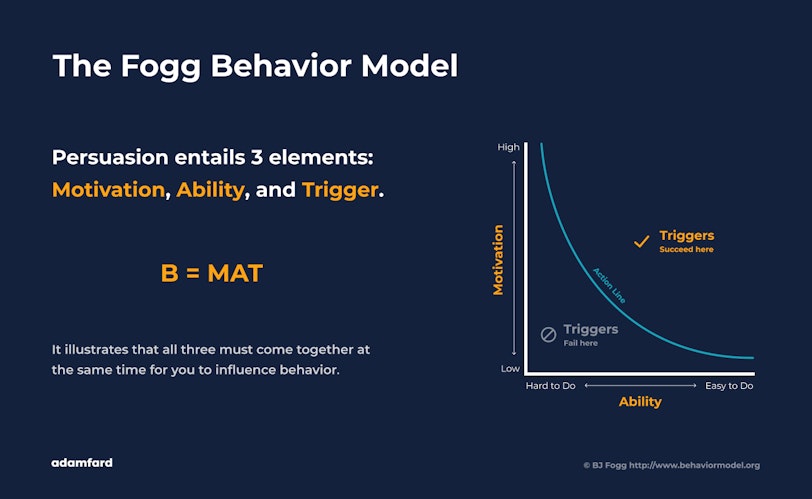Persuasive design is about creating experiences that nudge users to take desired actions. Many of its techniques are rooted in psychology. From persuasive patterns to behavioral models, you have different methods to choose from.
As with designing user experience, you don’t design for everyone. Think about your target audience. Then, use focused persuasive techniques that will work best on them. Now, the question is: Which ones can you use?
Let’s get right into it.
Persuasion Techniques Definition
Persuasion techniques are ethical design methods — they don’t involve coercion at all. They don’t make users feel like they are being manipulated.
It might be tempting to use every technique you can think of. But that can do more harm than good. Implementing random techniques makes the experience cluttered. It also makes users feel manipulated. They will abandon the site the moment they sense that they are not in control.
If you want to persuade users to perform desired behaviors, keep everything simple. Put more thought into your persuasive techniques. Carefully select the practices you want to implement. Make sure they work best for your audience.
Effective Persuasion Techniques
Users decide if they want to stay or leave the moment they enter your site. Aim to provide them with a greater sense of autonomy and freedom to make their own choices. This will ease any apprehension they may have and boost feelings of certainty.
Here are a few techniques that might help.
Providing a sense of control
Crafting interfaces that are as functional as they are engaging will give users a greater sense of control. This will lead to a satisfying user experience.
It is in our nature to possess a need for control. You need to offer users positive experiences in the digital environments that you develop for them. In other words, you have to deliver tools that will make users feel more in control of their own journey.
In real estate, for instance, platforms such as Zillow make use of filters. These help users set criteria, limit their options, and find ideal homes or properties that match their standards.
Following the behavioral model

Persuasion entails three elements: motivation, ability, and trigger. This is called The Fogg Behavior Model. It illustrates that all three must come together at the same time for you to influence behavior.
Give users motivation or a reason to accomplish a task. Give them the ability to perform that task effortlessly, then trigger that user to act. You won’t always find situations with the right balance of each element. One will often outweigh the other and that’s perfectly fine.
Take Twitter, for instance. The motivation to tweet might be low, but the ability to do so is high.
Adding an escape from linear flows
Avoid forcing users into tunneled workflows that they can’t escape from. Instead, allow them to skip steps, leave the experience, and return if they wish.
Forcing untimely introductions will make users feel trapped. That’s why you should always offer users a quick escape from forced linear flows. Introductory videos and guided tours are a few examples of these.
Wepik, an online editing platform, can help users get comfortable with the interface and avoid confusion. The platform allows users to create and edit documents in a linear flow, but it also offers an option for guided tours.
Elements of Persuasion
Now that you know what persuasive design is, you should understand how to put it in practice. Listed below are a few persuasive patterns that you can apply to your product. These will help you create experiences that connect users’ pain points to the company’s solution. With enough frequency, you will be able to prompt an ideal behavior.
Personalization
Personalized information can be more effective in shaping attitudes and beliefs compared to generic data.
Tailoring experiences to fit the needs of the individual is a basic yet highly effective element of persuasive design. It allows you to simplify matters for users by showing them what is most relevant to their needs, personality, or interests.
Self-monitoring
Allow users to keep track of habits that they want to change. You can do this by showing them how well they are performing a specific behavior. In doing so, you will motivate them to continue performing the behavior. Through self-monitoring, users can learn more about themselves. They can further motivate themselves to carry on.
Throw in positive reinforcement as well. By letting them know that they are performing well, you are keeping them engaged and driven.
Triggers
Add slight triggers to nudge users to act. Triggers prompt users to perform an action in the context they’re in. These can be notifications, emails, SMS alerts, links, etc. Offline triggers count too. They can be alarms or reminder sheets.
Conditioning
Another powerful strategy in persuasive design is conditioning. It centers on reinforcing targeted behaviors. This entails learning when to use incentives and how to prevent reward fatigue. At the same time, it involves making consistent design decisions and using templates that prompt good habits.
One good example where you can apply this is when you’re getting people to fill in a user profile. Those who complete the profile will have access to the rest of the resources on the website, while those who don’t will only have limited access.
Persuasive design is nothing without the insights you gain through research. It enables you to understand the needs and motivations of users. At the same time, knowing your audience will also help you design functional and highly engaging experiences that trigger user behavior. Determine which part of the consumer journey users are more receptive to triggers. This way, you can craft design features that motivate them to act.
Whether you want to improve an existing website or develop a new app, persuasive design can help you drive more engagements, increase the average time spent on the platform, and perhaps even improve your sales.





